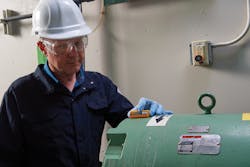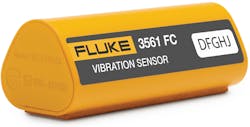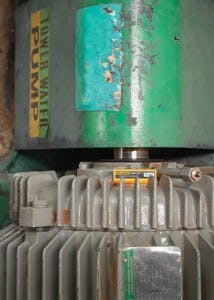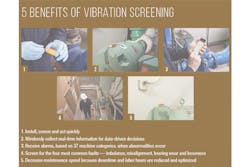Benefits of vibration sensors in multiple applications
Most plants, factories and other facilities have equipment installed that has been in operation for years — even decades. They must maintain the health of this long-installed equipment for sustained operations and minimized downtime. Keeping up with routes and scheduled maintenance on this growing number of aging assets can be time-consuming and difficult. Daily emergencies and a workforce that is retiring make keeping equipment running optimally a challenge.
Why vibration screening?
With vibration screening, teams can triage the health of assets. Then if needed, they can conduct further analysis to diagnose the fault (perhaps with a vibration analyzer or other condition monitoring technology). With this data, they perform the right corrective action at the right time.
Installing a vibration sensor on equipment allows teams to spend less time taking manual readings on assets that may be completely healthy. They instead spend their time addressing actual problems that need attention.
Simplified monitoring
Including vibration sensors in industrial maintenance programs may seem daunting, but it has never been easier to screen assets. With some vibration monitoring systems, the sensor can be installed in less than an hour. Within minutes, teams start to receive data and get the information they need to make data-driven decisions.
Data can be viewed and analyzed in the plant or across the globe. Wireless, continuously streaming sensors can become an important part of any maintenance and reliability program that monitors rotating assets. Cloud-based software stores and delivers data, giving all team members insight into asset health. Vibration screening is an economical way to monitor more assets by automating data collection, helping teams along their path to predictive maintenance.
Most equipment can benefit from condition monitoring. By including sensors, teams will have a clear view of asset health and efficiency. In addition, many industries will benefit from condition monitoring, including vibration screening.
This vibration sensor wirelessly collects continuous data and is easy to install and scalable to cover more assets affordably.
HVAC
Fans and compressors are critical for properly operating HVAC systems. The air keeps flowing and machinery remains cool when remote vibration sensors are installed. Data gathered by vibration sensors notifies maintenance teams of potential problems.
Chemical
Chemical processing requires robust equipment that operates optimally for long periods. The materials flowing through pumps and contacting piping can be highly corrosive and hazardous. Maintaining the assets and early warning of failures can be important for the equipment’s health but also for personnel. Downtime can be dangerous and costly for chemical processors.
Food and beverage
The food and beverage industry relies heavily on rotating equipment, such as gearboxes, chillers, pumps and rollers. Downtime may halt the entire production line. Real-time and historical vibration data help teams trend, analyze and interpret information collected from assets.
Pumps and motors are two asset categories that can be screened for abnormalities with a vibration sensor.
Water and wastewater
More important than the financial costs, pump downtime in water distribution and wastewater plants negatively impacts customer access and water quality. Installing vibration sensors on noncritical assets ensures that water plant teams move more maintenance in-house, reduce costs and minimize time-based routes.
Oil and gas
Oil and gas operators have facilities in remote places that experience weather extremes, dust and sand. Engineers and technicians need rugged technology to live up to the rigors of these locations. With any smart device, team members can see the asset’s status without traveling to difficult-to-access sites.
Automotive
Scaling condition monitoring programs for enterprise-level facilities may be cost-prohibitive, but it does not have to be. With a multitude of assets, cost-effective installation of sensors is key. Sensors that are easy to implement allow teams to economically extend coverage throughout the plant.
A solution for rotating assets
Teams can improve the health of most rotating assets with vibration screening. Using vibration sensors that have cloud-based data simplifies data aggregation. Teams should keep information from multiple sensors and handheld tools in one, easy-to-use place.
Teams can improve noncritical and semicritical asset reliability by monitoring for conditional changes to extend the life of equipment, obtain the information needed to make data-driven decisions and spend less time on reactive repairs by analyzing information provided by vibration sensors. Not only will including vibration sensors in a facility simplify and target maintenance tasks, but it will also help teams experience increased equipment reliability.
The assets in facilities are increasing, but the types of assets are also expanding. With a multitude of equipment under their control, route-based maintenance can be difficult for teams to complete while attending to other daily activities. Most machinery benefits from some kind of remote monitoring program. Assets that should be monitored for excess vibration include:
- Motors
- Pumps
- Compressors
- Gearboxes
- Fans and blowers
- Automated assembly lines
Throughout most process industries and discrete manufacturing, these assets operate for long periods — often 24 hours each day, seven days per week. Their health is a vital concern for maintenance and reliability teams and their leadership. Vibration monitoring can be an easy and scalable way to determine when assets need the maintenance team’s attention.




